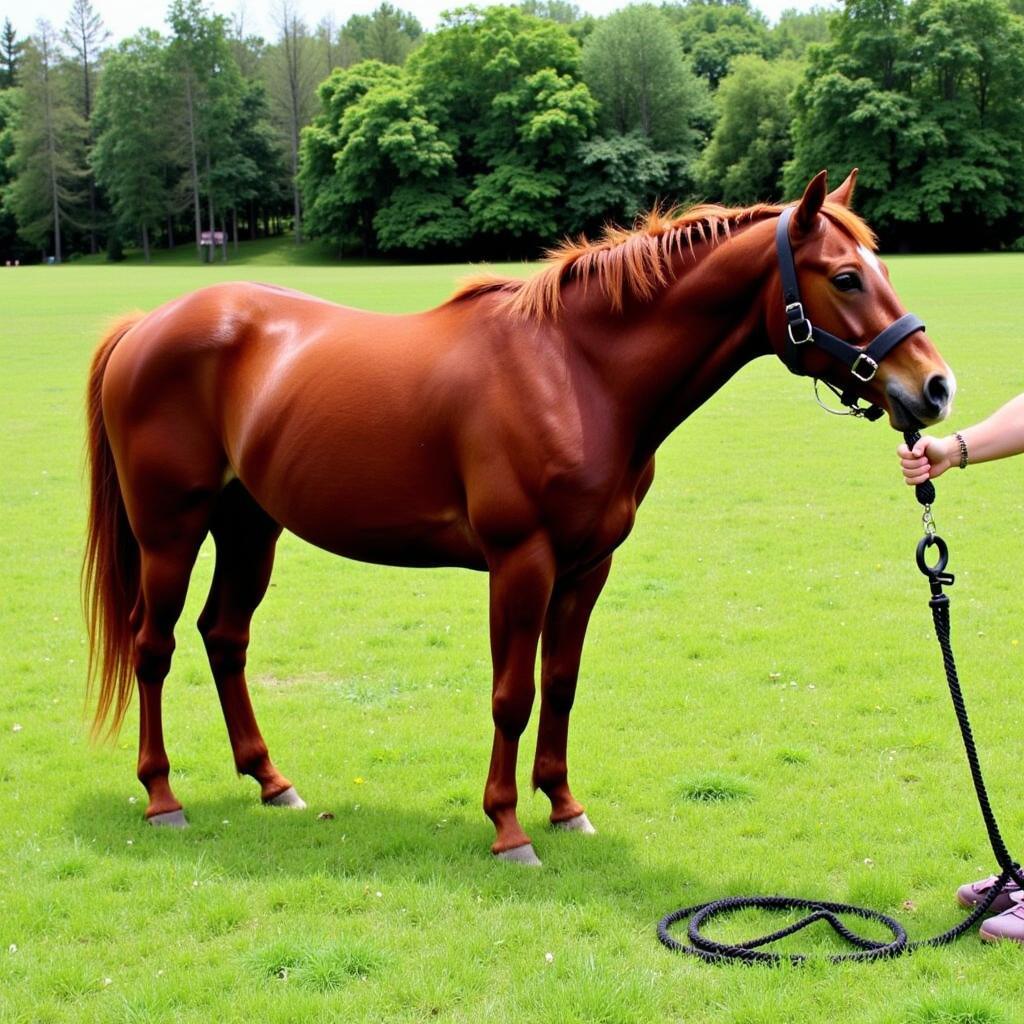Ground tying a horse is a valuable skill that offers convenience and safety for both horse and handler. It teaches the horse patience and respect, allowing them to stand quietly while you attend to other tasks. This article will explore the methods and considerations for successfully teaching your horse how to ground tie.  Horse Ground Tied Safely
Horse Ground Tied Safely
Understanding Ground Tying
Ground tying essentially means teaching your horse to stand still as if tied to a fixed object, but without actually being physically tied. It’s about establishing a designated spot where the horse understands it must remain until released. This can be incredibly useful when you need to briefly step away, such as adjusting tack, opening a gate, or tending to another horse. It’s a testament to the trust and communication you’ve built with your equine companion.
Before you begin, ensure you have the proper equipment. A good quality training halters for horses is essential. While ground tying, the halter acts as a point of communication and pressure, reinforcing the desired behavior.
Preparing Your Horse for Ground Tying
Ground tying should not be the first lesson in your horse’s training repertoire. Basic obedience, such as leading and yielding to pressure, is crucial. Your horse needs to understand and respond to your cues, both verbal and physical. A solid foundation in groundwork is essential before introducing the concept of ground tying. Work with your horse in a safe, enclosed area like a round pen horse. This will help prevent any potential escapes and keep the training sessions focused.
Steps to Teach Ground Tying
- Introduce the “Stand” Cue: Begin by asking your horse to stand still using a clear verbal cue like “stand” or “whoa.” Use consistent body language, such as a relaxed posture and direct eye contact. Reward even the slightest attempt at stillness with a gentle pat and praise.
- Use a Visual Marker: A patience pole for horses or even a small weight can serve as a visual marker for the horse to associate with standing still. Place the marker on the ground and ask your horse to stand next to it. Gradually increase the duration of the stand.
- Step Away Gradually: Once your horse consistently stands at the marker, begin taking small steps away while maintaining eye contact and repeating your “stand” cue. If your horse moves, calmly lead them back to the marker and start again.
- Increase Distance and Duration: As your horse progresses, gradually increase the distance and duration of the ground tie. Be patient and reward the smallest successes. Don’t rush the process; it’s better to build slowly and solidify the behavior.
- Introduce Distractions: Once your horse is reliably ground tied in a quiet environment, gradually introduce distractions, like another horse walking by or a sudden noise. This helps generalize the behavior and ensures your horse remains grounded even in stimulating situations.
Troubleshooting Common Issues
-
Horse walks away: If your horse consistently walks away, shorten the distance and duration of the ground tie. Re-establish the “stand” cue and ensure they understand the expectation. You may need to revisit basic obedience training.
-
Horse paws or becomes restless: Ensure your horse isn’t physically uncomfortable. Check for any tightness in the equestrian horse equipment. Consider using hobbles horse in controlled training sessions if pawing is excessive, but always under the guidance of an experienced horse trainer.
-
Horse pulls back: This is a serious safety concern. Never ground tie a horse with a regular halter and lead rope. If your horse pulls back, immediately return to basic groundwork exercises focused on yielding to pressure.
“Ground tying is all about patience and consistency,” says renowned horse trainer, Amelia Cartwright. “It’s a partnership built on trust and clear communication. Take your time, celebrate the small wins, and always prioritize your horse’s safety.”
Conclusion
Learning how to ground tie a horse takes time, patience, and consistency. By following these steps and focusing on clear communication, you can successfully teach your horse this valuable skill. Remember to prioritize safety and always work in a controlled environment. A well-trained, ground-tied horse is a testament to the strong bond you share and a valuable asset in your horsemanship journey.
FAQs
- How long does it take to teach a horse to ground tie? It varies depending on the horse’s age, temperament, and previous training. It can take a few sessions or several weeks.
- Can all horses be ground tied? Most horses can learn to ground tie, but some may have physical or behavioral limitations.
- What should I do if my horse breaks the ground tie? Calmly lead the horse back to the designated spot and reinforce the “stand” cue. Shorten the duration and distance, starting again.
- Is ground tying safe? Yes, when done correctly. Ensure you’re in a safe environment and using appropriate equipment.
- What are the benefits of ground tying? It allows you to briefly step away from your horse while maintaining their safety and promoting patience.
- Can I ground tie my horse anywhere? It’s best to start in a controlled environment and gradually introduce new locations.
- What if my horse becomes anxious while ground tied? Return to earlier stages of training and build up their confidence slowly.
Common Scenarios
-
Young Horse: Start with very short durations and gradually increase the time. Use positive reinforcement and lots of praise.
-
Experienced Horse with No Ground Tying Experience: Treat them as you would a young horse, starting from the basics.
-
Anxious Horse: Work in a quiet, familiar environment. Use calming techniques and be extra patient.
Further Reading & Resources
Check out our other articles on hobbles horse and round pen horse for more information on horse training techniques.
For further assistance, please contact us: Phone: 0772127271, Email: [email protected] Or visit us at: QGM2+WX2, Vị Trung, Vị Thuỷ, Hậu Giang, Việt Nam. We have a 24/7 customer support team.